

Of Note...
Brian Remer Receives Award for Lifetime Achievement. Read about it here:
What We Do
The Firefly Group helps people connect their every-day tasks with a bigger, wider sense of purpose and meaning. After working with Firefly, people are energized to attain the mission of their organization and they have a specific action plan to help them achieve their goals.
We do this through leadership development, performance improvement training, strategic planning, and clarification of organizational mission and vision. Our methods are engaging, thought-filled, and results-oriented.
If this sounds like a good direction for your organization, let's talk about how we might collaborate! Please give me a call (802.257.7247) or send an . - Brian
Where Can You Catch The Firefly Group?
Rotary
Club,
Brattleboro, VT
May 3
Say It Quick! Presentation
ASTD,
Lincoln, NE
May 17
Keynote Presentation and Performance Improvement Workshop
North
American Simulation & Gaming Association (NASAGA),
Columbus
November 7 - 10
Keynote Presentation, Game Design Certificate Program Leader
 Your ETR (Estimated Time to Read): 10 minutes Your ETII (Estimated Time to Implement Ideas): 5 weeks |
May 2012
|
Say
It Quick |
Discoveries bits of serendipity to inspire and motivate |
Ideas fuel for your own continuous learning |
Activities tips and tricks you can try today |
| Stay Inside the Lines | Imagine: How Creativity Works | Revised Rules for Brainstorming |
How Creativity
Works
This month we'll explore the origin of our imaginative impulses as well as
what nourishes them. But we'll begin with a 99-Word Story about the social
pressures that actually curb creativity.
Stay Inside the Lines
I bought a box of colored pencils for my daughter. Printed on the package was this ringing endorsement: "Preferred by teachers." What, I wondered, does that really mean? Why do teachers like these pencils? Do they help children color inside the lines? Have schools "approved" the hues? There was no explanation.Say, who cares what teachers think? Teachers don't use colored pencils; kids do. But parents buy them and they want to please teachers!
It's easy to please the wrong person if you haven't thought about why you're trying to please in the first place.
 Imagine:
How Creativity Works
Imagine:
How Creativity Works
by Jonah Lehrer
Touch your finger tips to your head above your right ear. That spot just under
the skull is your center of creativity. It's the area of your brain responsible
for the freewheeling thoughts that we call imagination. It's the part of the
brain that makes connections without evaluating their validity, relevance,
or practicality. Stimulate that area of the cortex with a minor magnetic pulse
and you'll experience a greater flow of free associative thinking. Ideas start
above your right ear then get passed over to the left side for critical analysis,
refinement, or to work out the practical details.
Breaking brain science is only one approach to explaining creativity that Jonah Lehrer takes in his book Imagine. Lehrer examines the creative process used by artists, engineers, writers, scientists, and musicians to shed light on how anyone can increase their imaginative output whether individually or as a member of a group.
Lehrer's writing reinforces the work of other authors on the creative process. The ideas he describes dovetail with those of Steven Johnson in his book Where Good Ideas Come From and of Stephen Lundin's CATS: The Nine Lives of Innovation. (Both have been reviewed in The Firefly News Flash.) These authors have all identified similar conditions that foster innovation, creativity, and imagination: the intermingling of very different fields of interest; the importance of free association; the tolerance of chaos and ambiguity; and the embrace of errors which lead to further experimentation.
But Lehrer adds to this discussion with current research about brain chemistry, social networks, and the conditions for both individual and group creativity. Taking the book as a whole, one can see the scalability of creativity. In the brain, diverse ideas need a chance to intermingle so they can be reordered in new and startling combinations. In the workplace, people need the opportunity to bump into colleagues from different departments for innovation to spring from the collision of their disparate ideas. And in the larger community, cities provide a venue for the greatest number of innovations because the density of diverse people increases the chance encounters that lead to imaginative breakthrough thinking.
Other highlights of the book include:
Our culture frequently discourages the sharing of innovative ideas by means of patents, copyrights, company policies, non-competition agreements, confining people to their own departmental responsibilities, or even approving the shades and hues in their box of colored pencils! In contrast, Lehrer repeatedly makes the case that ideas become more valuable when they are shared and his book provides inspiration for individuals, teams, and organizations who want to do just that.
Imagine: How Creativity Works by Jonah Lehrer, Houghton Mifflin Harcourt, 2012, ISBN: 978-0-547-38607-2
 Brainstorming
is Broken
Brainstorming
is Broken
What, brainstorming does not work?
There are several ways Lehrer's book Imagine challenged my own assumptions about how creativity works and this was one of them. I remember my first exposure to brainstorming as a teenager during a youth leadership meeting. We were asked to invent as many uses as possible for a paper cup. As a facilitator, I have relied upon the technique for my whole career. I have used countless variations and even led an activity that confirms for participants that their collective imagination is superior to their individual effort.
Lehrer describes how much energy at Pixar is focused on meetings to refine ideas. Several hours might be spent with editors, animators, writers, and others redesigning a film sequence frame by frame. But this relentless critique seems to contradict my own experience that ideas get better when we build upon them rather than when we focus on fixing the flaws. The concept of "Yes, Andů" is an example of this. In the April 2012 issue of The Firefly News Flash I explained how this technique can expand possibilities rather than shut innovation down. It's essential for the creativity of improvisational theater and useful in many other situations.
In his discussion of the creative process at Pixar, Lehrer explains that the daily meetings are often "brutally critical" and that participants sometimes need to shield their ego from these attacks. But he argues that the candid discussion of mistakes is effective because accepting such errors reduces their long-term cost. People will offer more ideas if they know the imperfections of their thinking will be corrected sooner rather than later. Lehrer even quotes research that indicates angry people can produce more creative ideas! Of course, this comes at a cost: anger is a drain for those who are angry as well as their targets and the strain on relationships can be difficult to repair.
Almost as a footnote, Lehrer concedes that Pixar has modified its process of critique to include what it calls "plussing." When someone makes a criticism, they are also encouraged to add a new idea that will help people move on to thinking about a solution. Plussing sounds like "Yes, Andů" to me. Each concept is analyzed for the value it adds then it becomes the foundation of other expansive ideas.
Ultimately, when we work together the ideas we talk about do not pop into existence from a vacuum. Ideas are always connected to the experiences, hopes, aspirations, and dreams of the mind that invented them. If we want those ideas to keep coming, we've got to maintain a positive relationship with the person in control of that wonderfully inventive mind.
Revised Rules
for Brainstorming
Based on Lehrer's Imagine, the critique meetings at Pixar, and my experience
with "Yes, Andů" I'd like to suggest some new rules for brainstorming. The
difference is adding "skillful discussion" to foster a process of dialogue.
And the key is in defining what is meant by this term. Peter
Senge, in The Fifth Discipline Fieldbook (ISBN 0-385-47256-0, Doubleday, 1994), writes about the importance of balancing advocacy for our own point of view with inquiry about the source and assumptions behind the ideas of others. In order to derive new insights, we have to get to the bottom of ideas as they are initially presented. We need to share our ideas and invite others to question and expand them. Senge calls this "skillful discussion" to distinguish from the common definition of discussion which means "to shake apart." The intention is to create a flow of dialogue where both our thinking and the thinking behind our thinking are revealed. As a result, both ideas and their inventors are respected and the group expands its level of both creativity and trust.
Brian's Brainstorming Rules
1. State the problem or issue that is up for consideration.
2. Allow 5 to 8 minutes for participants to work silently and independently writing a list of as many solutions to the issue as they can.
3. Explain that the latest research shows that groups can be most creative when they generate, expand, and work out the potential problems of their ideas.
4. Invite all participants to share their ideas and the airtime. "Let someone else share a thought before you offer another contribution of your own."
5. When someone gives an idea, each person has several options:
- Keep silent
- Offer a completely different idea
- Expand, "Yes, what I like about your idea is [name what you like], and we could also [insert new idea]."
- Inquire, "I understand some of what you are saying but can you explain [insert concept] a bit more?"
- Relate, "Your idea is similar to [insert previous idea] that we talked about earlier because [name the relationship]."
6. Record all ideas, expansions, inquiries, and relationships on a flipchart or computer.
7. Make sure each participant has contributed at least one idea or one comment.
8. Follow a similar process as the group conducts a skillful discussion about their priorities. Rank the ideas and suggestions from most to least preferred or set another meeting time to do this.
I believe these rules will enable you bend the usual social expectations about brainstorming to take advantage of the latest thinking about how creativity works without prescribing which colors to use or forcing anyone to "stay within the lines." Give them a try at your next brainstorming session then, please, what happened!
|
If you like what you have read in this issue, I would like to bring the same innovation, creativity, and playfulness to your next meeting or learning event. Whether you need a keynote speaker, or help with strategic planning, performance improvement, or training facilitators and trainers in your organization, I look forward to your call (802.257.7247) or . -- Brian |
Read previous
issues. Click Library!
To add or delete your name to our mailing list, email
with a short note in the subject line.
I want this newsletter to be practical, succinct, and thoughtful. If you have suggestions about how I can meet these criteria, please let me know! Send me an with your thoughts and ideas.
Home
| Services
| Products
| Mission
| Ideas |
The Group
| The Buzz
(c)
2012 The Firefly Group